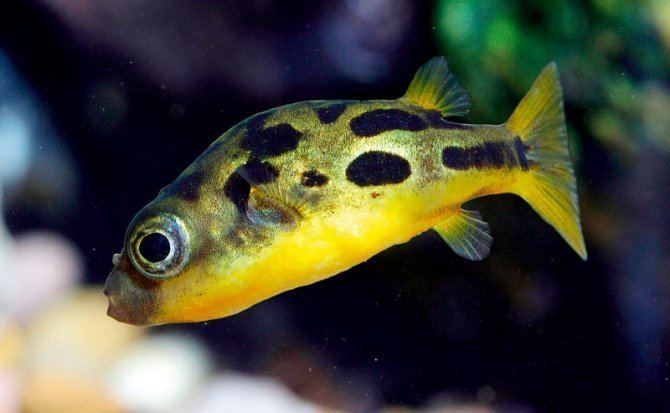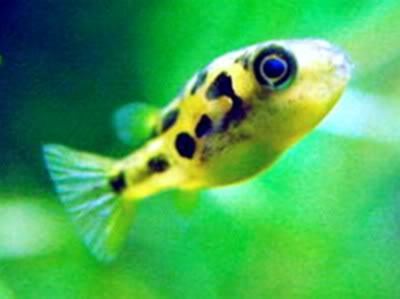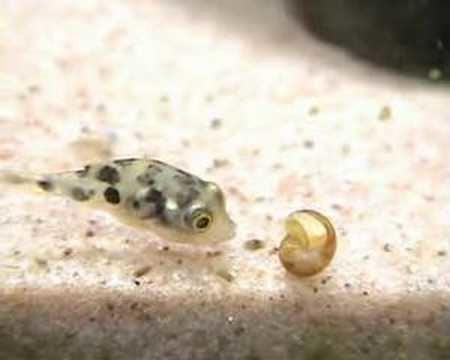Higher classification Carinotetraodon Rank Species | Phylum Chordata | |
 | ||
Scientific name Carinotetraodon travancoricus Similar Pufferfish, Carinotetraodon, Tetraodon, Dichotomyctere nigroviridis, Colomesus asellus | ||
Feeding dwarf pufferfish
The dwarf pufferfish (Carinotetraodon travancoricus), also known as the Malabar pufferfish (leading to easy confusion with the related C. imitator), pea pufferfish or pygmy pufferfish, is a small, freshwater pufferfish endemic to Kerala and southern Karnataka in Southwest India. The maximum documented size is 3.5 cm (1.4 in), making it one of the smallest pufferfish in the world. Although closely related to marine pufferfish, they are not found in salt water, and reports to the contrary are based on misidentification.
Contents
- Feeding dwarf pufferfish
- Range and status
- Description
- Diet and behavior
- In aquaria
- Reproduction
- References

Range and status

The dwarf pufferfish is endemic to Kerala and southern Karnataka in the Western Ghats of Peninsular India. In Kerala it is known from 13 rivers (as well as estuaries), including Chalakudy, Pamba, Periyar, Kabani, Bharathappuzha, Muvattupuzha, Achenkovil and Vamanapuram. It is also known from other freshwater habitats in the region such as Lake Vembanad and the Thrissur Kole Wetlands.

The dwarf pufferfish is classified as vulnerable on the IUCN Red List due to habitat loss and overharvesting for the aquarium trade. It remains common in some rivers, but it is rare in others and overall it has been estimated that the species declined by 30–40% from 2005 to 2015. Dwarf pufferfish are found in some reserves such as the Neyyar Wildlife Sanctuary.
Description

Sexing of juveniles is impossible because these fish "choose" their sex as they mature. Once one pufferfish begins becoming a male he excretes hormones to prevent the other puffers from becoming male. However, if two fish start to mature into males at the same time one will become the dominant male. There is also a dorsal crest, but it lacks special colouration when not erect. Both crests are displayed during courtship while the male circles the female. They also will have more yellow colouration.
Both sexes are primarily yellow with dark green to black iridescent patches on the flanks and dorsal surface, but as with other members of the genus, sexual dimorphism is apparent in mature fish, with males being more brightly coloured than females. Males can also have a dark stripe down the center of their pale belly and iridescent "eye wrinkle" patterns that females do not have. Females are more rounded, tend to be a bit larger than males, and may or may not show more smallish spots between their larger dark markings.
Diet and behavior

The diet of dwarf pufferfish in the wild mainly consists of small animals such as cladocera, rotifers, copepods and insects, but it also eats plants such as diatoms. Sand and detrius, presumably ingested by mistake when feeding on small bottom dwelling animals, has also been found in the gut of dwarf pufferfish. Other members of the genus feed on zooplankton and various benthic crustaceans and molluscs. Food items of specimens maintained in aquaria appears to be similar.

Unlike many pufferfish species that are solitary and fiercely territorial, the dwarf pufferfish occurs in shoals in the wild.
In aquaria
Dwarf pufferfish have become quite popular as aquarium fish thanks to their attractive colours, small size, and relative ease of maintenance. Like all pufferfish, they can be aggressive, especially towards creatures smaller than themselves, and it is commonly recommended to keep them in a dedicated "species only" tank. A female to male ratio of 3 to 1 is sometimes recommended to reduce aggression in captive fish.
The dwarf puffer is one of the few aquarium fish to regularly eat small live snails and can be useful in controlling snail populations (larger snails do not interest them).
A small tank of about ten gallons is acceptable.
Reproduction
Often dwarf pufferfish are plant-spawners, laying eggs in plants, including java moss in aquariums. Eggs have been seen to hatch after five days at 27 °C (81 °F), with fry initially feeding on infusoria, brine shrimp when they are a week old, and finally regular-sized food when possible. Dwarf pufferfish have also been known to scatter their eggs on the substrate hidden within vegetation. The eggs are fertilized externally. They do not guard their eggs or fry. After the eggs hatch, take out the fry; it is not recommended that you keep the adults and the fry together.
